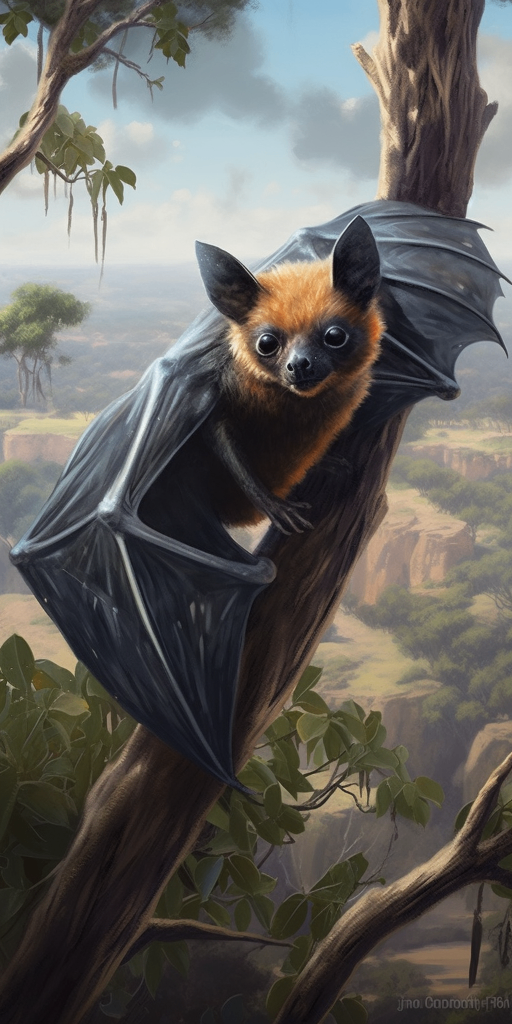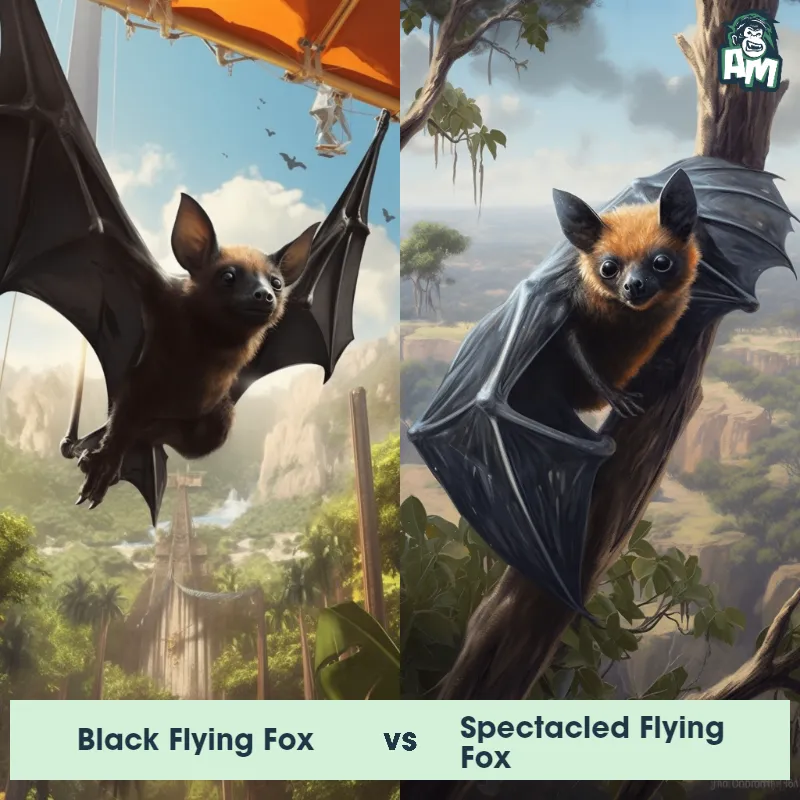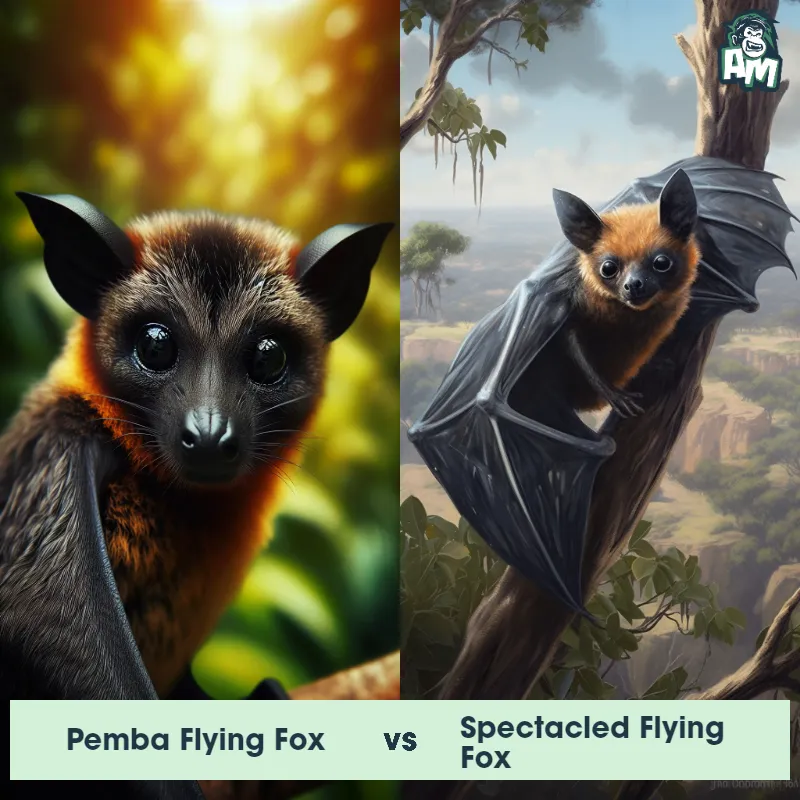The Spectacled Flying Fox
The Spectacled Flying Fox, also known as the spectacled fruit bat, is a large bat species found in Australia's northeastern regions. These bats have a wingspan that can reach up to 1 meter and are easily recognizable by the distinctive cream-colored fur around their eyes, which resembles glasses or spectacles. They have a dark brown to black body, a pointed snout, and large ears. Spectacled Flying Foxes primarily feed on fruit and nectar and play an essential role in pollination and seed dispersal in their habitat.

| Spectacled Flying Fox | |
|---|---|
| Size | Wingspan up to 1 meter (3.3 feet); Length up to 25 cm (9.8 inches) |
| Weight | Up to 1 kg (2.2 lbs) |
| Speed | Speed: 25 mph (40 km/hr) |
| Key Strength | Sharp teeth and claws |
| Biggest Weakness | Vulnerable to disturbance and habitat loss |
| Scientific Name | Pteropus conspicillatus |
| Family | Pteropodidae |
| Habitat | Forests and woodlands |
| Geography | Australia, Papua New Guinea, and Indonesia |
| Diet | Fruit, nectar, and pollen |
| Lifespan | 10 years - 30 years |

The Spectacled Flying Fox
The Spectacled Flying Fox, also known as the spectacled fruit bat, is a large bat species found in Australia's northeastern regions. These bats have a wingspan that can reach up to 1 meter and are easily recognizable by the distinctive cream-colored fur around their eyes, which resembles glasses or spectacles. They have a dark brown to black body, a pointed snout, and large ears. Spectacled Flying Foxes primarily feed on fruit and nectar and play an essential role in pollination and seed dispersal in their habitat.
Fun Fact: Spectacled Flying Foxes are skilled flying mammals that can cover long distances while foraging for food, with some individuals known to travel over 100 kilometers in a single night.
| Spectacled Flying Fox | |
|---|---|
| Size | Wingspan up to 1 meter (3.3 feet); Length up to 25 cm (9.8 inches) |
| Weight | Up to 1 kg (2.2 lbs) |
| Speed | Speed: 25 mph (40 km/hr) |
| Key Strength | Sharp teeth and claws |
| Biggest Weakness | Vulnerable to disturbance and habitat loss |
| Scientific Name | Pteropus conspicillatus |
| Family | Pteropodidae |
| Habitat | Forests and woodlands |
| Geography | Australia, Papua New Guinea, and Indonesia |
| Diet | Fruit, nectar, and pollen |
| Lifespan | 10 years - 30 years |
Spectacled Flying Fox Matchups
We use AI to simulate matchups between the Spectacled Flying Fox and other animals. Our simulation considers size, strength, and natural predatory behaviors to determine the most likely outcome.

Can't find the Matchup you want?
Create Your Own MatchupSpectacled Flying Fox: Diet, Predators, Aggression, and Defensive Behaviors
What do Spectacled Flying Foxes eat?
Spectacled Flying Foxes primarily feed on nectar and fruits. They have a specialized diet that includes flowers, pollen, and fruit from a variety of plant species, which helps in their role as important pollinators in their habitat.
Do Spectacled Flying Foxes have any predators?
Yes, Spectacled Flying Foxes do have predators in the wild. Their main predators include birds of prey such as owls, and large predatory mammals like snakes and goannas. These predators pose a threat to both adult flying foxes and their young.
Are Spectacled Flying Foxes aggressive?
Spectacled Flying Foxes are not known to be aggressive towards humans or other animals unless they are provoked or feel threatened. They are generally docile creatures that prefer to avoid confrontation and will typically retreat to safety if they feel threatened.
Do Spectacled Flying Foxes engage in fights?
Spectacled Flying Foxes may engage in fights within their own colony, especially during breeding season when competition for food and mates can be intense. These fights typically involve vocalizations, posturing, and physical confrontations such as biting and scratching.
How do Spectacled Flying Foxes defend themselves?
Spectacled Flying Foxes primarily rely on their agility and speed to defend themselves from potential threats. They are capable of swift flight, making it difficult for predators to catch them. Additionally, they may vocalize loudly or emit strong odors to deter predators.
What is the biggest weakness of Spectacled Flying Foxes in a fight?
One of the biggest weaknesses of Spectacled Flying Foxes in a fight is their vulnerability while roosting in large colonies. Predators may take advantage of their clustered sleeping arrangement to launch surprise attacks and catch the flying foxes off guard. This increases the risk of predation, especially during nighttime when they are most vulnerable.
Fun Fact: These bats have developed unique adaptations to locate food during their nocturnal flights, including excellent night vision and the ability to detect the scent of ripe fruit from a remarkable distance of up to 25 kilometers away.
Fun Fact: Spectacled Flying Foxes have a complex social structure and form large colonies, with some populations ranging from a few hundred to thousands of individuals gathering in communal roosts during the day, where they hang upside down from tree branches.












